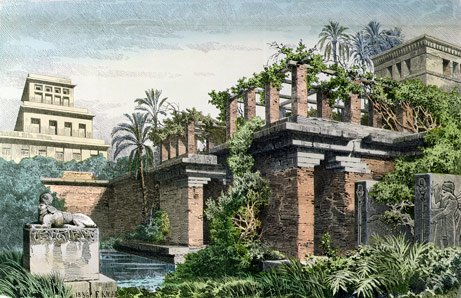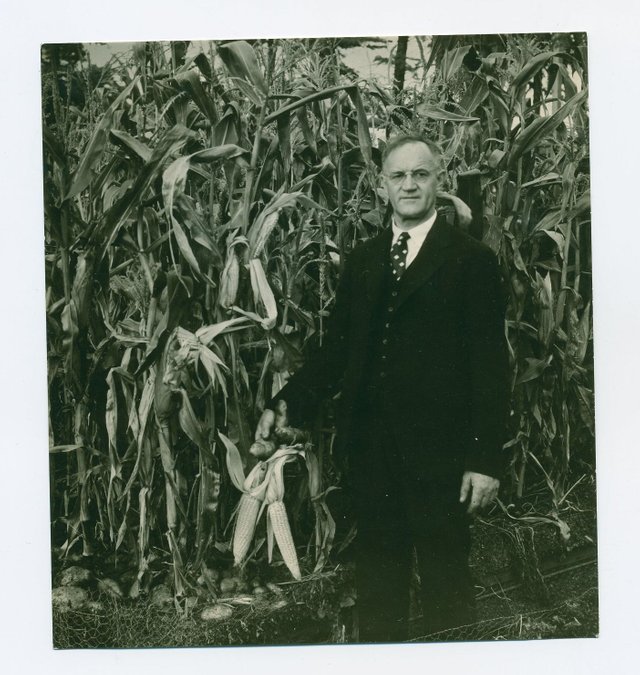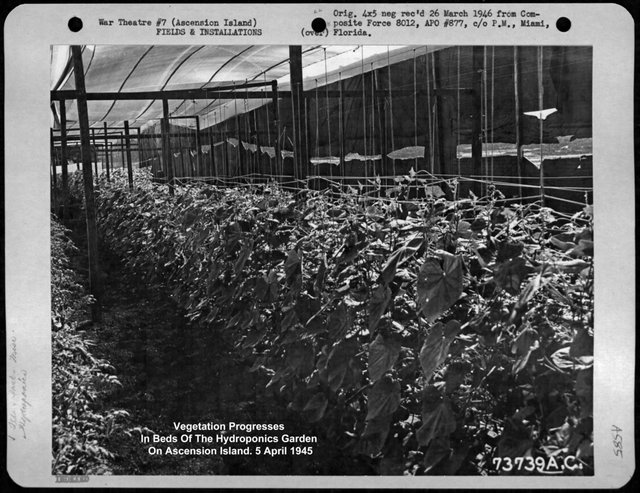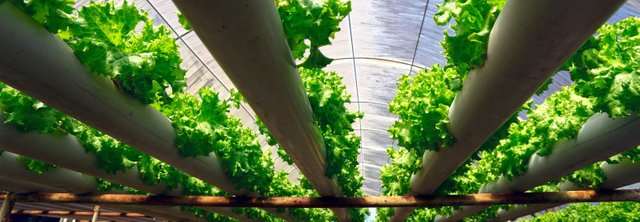The History of Hydroponics
Hydroponics is a modern technology with roots in the origin of Earth. In fact, hydroponics is the oldest form of growing with ocean-going photosynthetic algae and photosynthetic bacteria actually existing before terrestrial plants, helping to produce the oxygenated environment we breathe today.
Modern hydroponics was developed from the findings of experiments carried out to determine plant composition dating back to the early 1600’s, but plants were being grown in soilless culture far earlier than this, even if it was not identified directly as hydroponics. The worlds rice crops have been grown hydroponically from time immemorial, as they are to this day.

The first known instance of water-based hydroponics is in the Hanging Gardens of Babylon, one of the Seven Wonders of the Ancient World. The gardens thrived off of an elaborate watering system that supplied a steady stream of river water rich in oxygen and minerals. Located on the East bank of the Euphrates River near present day Baghdad, the gardens were built by King Nebuchadnezzar II (604–562 BC) to please his wife Amyitis.
Similarly, ancient Egyptian hieroglyphics dating back to several hundred years BC depict the growing of plants along the Nile River without soil, as do the floating gardens of the Chinese, as described by Marco Polo in his famous journal.

The Aztecs of Central America developed an ingenious method of utilizing the concepts of hydroponics. Treated with hostility by their more powerful neighbors and denied any arable land, they learned how to build rafts of rushes and reeds they called chinampas.
Chinampas were stalks and tough roots that were lashed together and loaded up with sediment from the shallow lake bottom. Because the sediment came from the lake bottom it was rich in a variety of organic compounds and minerals that the Aztecs used to nourish and grow plants.
The chinampas supported abundant crops of vegetables, flowers, and even trees. The roots of the plants grew through the floor of the chinampas allowing a constant water source and root oxygenation.
The chinampas were sometimes joined together to form floating islands as much as two hundred feet long flanked by waterways and drainage canals. Some chinampas even had a hut for a resident gardener. On market days, the gardener might pole his raft close to a marketplace, picking and handing over vegetables or flowers as shoppers purchased them. Talk about local agriculture!

The chinampas were such a success they supported a thriving civilization of over 200,000 people at the height of the Aztec rule, making it larger than any city in Europe at the time. A makeshift village invented out of creative desperation to stave off certain demise ultimately proliferated into a system of horticulture capable of supporting the capitol city of Central Mexico — a testament to the efficiency of intensive soilless culture.
When the Spaniards arrived in the New World, the sight of these floating islands must have astonished Cortes and his gang. William Prescott, the historian who chronicled the destruction of the Aztec empire by the conquering Spaniards, described the chinampas as “Wondering Islands of Verdure, teeming with flowers and vegetables and moving like rafts over the water.”
Chinampas continued in use on the lake well into the 19th century. Similar systems flourished in present-day Peru, Bolivia, and Ecuador well before Columbus’ arrival in the New World. Functional examples of the system persist today in Xochimilco in Mexico City and southwest Tlaxcala State, Mexico.
The earliest recorded scientific approach to discover the requirements of plant growth was in 1600 when Belgian Jan Van Helmont showed in his classic experiment that plants obtain substances from water.
He planted a 5-pound willow shoot in a tube containing 200 pounds of dried soil isolated to ensure accuracy. After 5 years of regular watering with rainwater he found the willow shoot increased in weight by 160 pounds, while the soil lost less than 2 ounces.
His conclusion that plants obtain substances for growth from water was correct. However, he failed to realize that they also require carbon dioxide and oxygen from the air.
The modern theory of chemistry made great advances during the 17th and 18th centuries and, along with the scientific method, revolutionized the scope of scientific research. The ability of scientists to work off a commonly agreed upon platform of chemical compounds allowed for a more spirited, and presumptuous, debate on the essential nutrition needed in order for plants to grow and laid the foundation of the modern perception of plant growth requirements.
In 1792, the English scientist Joseph Priestly discovered that plants placed in a chamber having a high level of carbon dioxide will gradually absorb it and give off oxygen.
A couple of years later, Jean Ingen-Housz carried Priestly’s work a step further and demonstrated that plants set in a chamber filled with carbon dioxide could replace the gas with oxygen within several hours if the chamber was placed in sunlight.
Ingen-Housz went on to establish that this process worked more quickly in conditions of bright light, and that only green parts of the plant were involved. Now we’re getting somewhere!
Through various experiments during the middle of the 19th century scientists determined the composition of plants and what substances they required for growth. It turned out that soil itself was not found to be directly beneficial to the plant for anything other than support and holding the required mineral elements needed for growth.
Of course, this is a gross generalization of the critical and dynamic role of humus and microbes in healthy soil systems, but, nevertheless, it paved the way to a greater understanding of essential plant requirements and hydroponic technology.
Rather than the soil itself, it turned out that it was the minerals incorporated into the soil, and the corresponding spaces in between (for oxygen), that the plants thrived off of. The next step towards the articulation of hydroponic technology was to eliminate the growing medium and grow plants in a water solution that contained all of the necessary minerals.
In 1860 Julius von Sachs, Professor of Botany at the University of Wurzburg, published the first standard formula for a nutrient solution that could be dissolved in water and in which plants could be successfully grown. The technique was termed “nutriculture”.
These early investigations in plant nutrition demonstrated that normal plant growth can be achieved by immersing the roots of a plant in a water solution containing salts of Nitrogen (N), Phosphorous (P), Sulfur (S), Potassium (K), Calcium (Ca), and Magnesium (Mg).
The elements Hydrogen (H), Oxygen (O), and Carbon © are all derived from the air and water. These nine elements are defined as the macronutrients.
With further refinement in laboratory techniques, scientists established seven elements required by plants in relatively small quantities, called micronutrients or trace elements. These include Iron (Fe), Chlorine (Cl), Manganese (Mn), Boron (B), Zinc (Zn), Copper (Cu), and Molybdenum (Mo).
The actual number of elements plants require is a matter of some debate, some say 15, others 17. However, as we will see, anyone who claims to have a complete understanding of the actual requirements for natural systems to operate at maximum efficiency is limiting the natural system.
Plants want MUCH more than they have to have. Even modern hydroponic nutrient solutions leave a lot to be desired, however, it is worth noting that hydroponic agriculture typically delivers a higher value of crop relative to the budget fertilizers used in conventional agriculture.
Interest in the practical application of nutriculture did not develop until around 1925, when the greenhouse industry expressed interest in its use. Greenhouse soils had to be replaced frequently to overcome problems of soil structure, fertility, and pests. All these problems were alleviated in soilless culture.

In 1929, Dr. William F. Gericke of the University of California effectively transformed his nutriculture laboratory into a commercial crop production operation.
First calling it “aquaculture”, he learned this term was already being used for aquatic organisms and termed his nutriculture systems “hydroponic”, meaning literally “water” (hydro) and “working” (ponos), or working water, in Greek.
His operation was a tremendous success. Newspapers printed outlandish headlines claiming an agricultural revolution with pictures of Dr. Gericke atop his ladder harvesting his 25 foot tomato plants.

According to author J.S. Douglas, “The American Press hailed it as the most colossal invention of the century, reporting…that farmlands had become relics of the past.” While we are currently in the midst of an agricultural revolution the claims of this “colossal invention” were premature because the techniques and systems themselves were rudimentary and required much technical knowledge.
The unfounded claims actually did more to harm the acceptance of hydroponics than it did to help. People feeding off the fervor created by the press banked on selling useless equipment to unknowing consumers hoping to take advantage of the new “colossal invention”. The disdain created by this farce lingered for many years and left the science of hydroponics dormant until our global endeavors deemed it undeniable.

Scientific curiosity in hydroponics was revived and government sponsored experiments began when World War II started in 1939. The United States and British Army’s established hydroponic units at military bases on several islands in the Pacific to provide fresh produce to troops during wartime.
After WW II the military continued to use hydroponics as its sole method of overseas food production. The US Army’s hydroponic branch grew over 8,000,000 pounds of fresh produce in 1952, a peak year for military demand. Some of the most successful operations have been those at isolated bases, notably in Guyana, Iwo Jima, and Ascension Island.
During the middle of the 20th century many setbacks were overcome, including crude environmental controls, poor growing mediums, and the use of unsuitable materials. Concrete used for growing beds became toxic and iron pipes corroded quickly, also releasing harmful or toxic substances into nutrient solutions.

With the mainstream adoption of plastics in the 1970’s hydroponics had finally arrived as a viable way of cultivation. Plastics freed growers from the costly construction and destructive properties of the early system components. With the development of suitable pumps, timers, plastic plumbing, and effective growing media hydroponic systems could now be automated, computerized, and streamlined reducing both capital and operational costs. Hydroponics could now be available for personal and commercial uses in a cost-effective manner.
Hydroponics has been adopted in the mainstream, and controlversially received adoption by the USDA for use in “organic”cultivation. The future of hydroponics is now. The technology addresses food and water scarcity, probably the two largest issues of the 21st century. It can produce 10x’s the yield per acre and use 1/20th of the water.
Hydroponics is better than what we find in the grocery store, but it has its drawbacks. Namely, hydro typically accounts for what plants require, not what they want. No method of growth will ever replace crops grown in the Earth under the sun. But with intention, we can learn to use this amazing technology for the betterment of humankind.
…
The future is open source and decentralized. Evan Folds pursues his passion of integrating the natural spiritual world with human centered technology by developing and sharing content shared across the digital landscape on Facebook, Twitter, and LinkedIn.